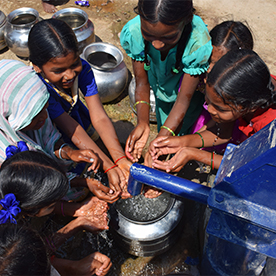

11 Min Read
Equipping and Training Pastors and Evangelists in India
Read More
4 Min Read
Mar 2, 2021



India, a beautiful country of 1.3 billion people, is the second most populous country in the world. Though the country is home to 17 percent of the world’s total population, India’s land area is only 2.4 percent of the world’s total land area.
Poverty in India has been a serious problem since the 19th century and is still a problem today. According to the World Bank, more than 270 million people are living in poverty despite India’s fast-growing economy and efforts to reduce poverty. The water problem in India is certainly heightened by the extreme poverty and inequality present. According to Global Citizen, “Water scarcity disproportionately affects vulnerable people in low-income communities." 600 million people in India are facing acute water shortages, and 200,000 people die every year from unsafe and unavailable water.
So, why do millions of people not have access to clean water? First, India is experiencing rapid population growth. Given that India only possesses four percent of the world’s fresh water but needs to support 17 percent of the world population, there is simply not enough water to go around.


Next, the water resources management in India is flawed. According to the World Bank, India is the largest net exporter of virtual water, has a water-dependent economy, and is one of the largest water users per unit of GDP. This suggests that much of India’s water scarcity is due to the lack of proper management. Further, there are few policies that support efficient management of water resources, and water regulation institutions are weak.
Climate change is another factor affecting the water shortage in India. “Quenching the thirst of 1.3 billion people is becoming especially difficult as wells are drying out and land is burning up amidst staggering heat waves." Because India relies on ground and surface water, warmer weather and less precipitation are further contributing to the water problem.
Not only is India facing a water scarcity crisis, but the country is also facing a water contamination crisis. The Global Alliance on Health and Pollution found that 15 percent of deaths in India are caused by pollution and 1.5 million children die from diarrhea every year. This means that the water that is available is usually inadequate for drinking. Urbanization, population growth, the absence of pipe planning, inadequate treatment of waste, poor sanitation, and open defecation all contribute to water pollution in India. This water contamination crisis is forcing millions of Indians to drink unsafe water, putting their health and lives at risk.
Set Free is an organization on a mission to bring fresh water to every man, woman, and child. Over the past 20 years, Set Free and its partners have given clean water to over 2 million people. Each well drilled provides clean water for an entire village of 750-1500 people, and the wells are drilled deep enough into the aquifers to run consistently through the rainy and dry seasons. Through drilling wells, Set Free is providing clean water to those affected by the water crisis.
What good is it, my brothers and sisters, if someone claims to have faith but has no deeds? Can such faith save them? Suppose a brother or a sister is without clothes and daily food. If one of you says to them, “Go in peace; keep warm and well fed,” but does nothing about their physical needs, what good is it? In the same way, faith by itself, if it is not accompanied by action, is dead.
-James 2:14-17


My command is this: Love each other as I have loved you.
– John 15:13



See how far your dollars go in making an impact in the lives of others.